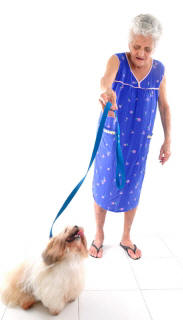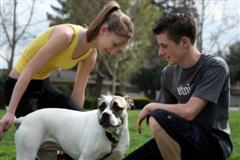Introduction
Exercise enthusiasts
know that jogging is one of the healthiest forms of
aerobic exercise for both the human and canine
jogger! A dog is a wonderful jogging or
walking companion but it is more fun for both if
certain rules are followed. For safety purposes, it
is helpful to teach the dog to ALWAYS wait for
permission before crossing a street.
|
The goal is for the dog
to stop at the curb because
he or she understands
"wait," not because the
leash is holding the dog
back. |
 Whoa
Nelly!
Whoa
Nelly!
Just before the curb, tell the dog to "Wait."
This Instruction cues the dog to stop and wait for
permission to cross the curb. If the dog steps
off the curb without permission, pull the dog back
or use a body block and say, "No!"
followed by the Instruction,
"Wait."
Praise
the dog for complying.
You may want to ask the dog to sit and wait. Do not
do any heavy jerking. Simply make it impossible for
the dog to proceed once the "wait"
Instruction is given.
Don't hold steady pressure on
the leash but do let the dog
stand at the edge of the curb.
If the dog steps off of the curb
again (without being given
permission), you just simply
pull him or her back again or
use a body block and say,
"Wait."
Then apply pressure to the
leash or use your body to move
the dog back an extra few feet
on the curb.
This may
have to be done repeatedly
before the dog understands what
you are trying to communicate.
When the dog has
been moved back several times, he or she will likely
give up and not try to step off the curb. Look for
this and praise the waiting at the curb, as long as
the leash has no pressure. The goal is for the dog
to stop at the curb because he or she understands
"wait,"
not because the leash is holding
the dog back.
After the dog has performed the
"wait" Instruction, say,
"Let's go" as the release word.
Then, YOU lead by stepping off
the curb and encouraging the dog
to follow you. Practice this
exercise on every curb until the
dog reliably learns the
"wait"
Instruction.
Moving Beyond The Curb
 Once the dog has mastered the
"wait"
Instruction (i.e., the dog
automatically stops at each
curb), you may decide you want
to cue the dog to either wait or
continue moving at curbs. Make
sure you give the dog the cue
word, such as "wait" or "let's
go" to help the dog learn that
you are setting the rules. The
dog needs to learn to pay closer
attention to you as you approach
a curb. It helps is you use
treats to reinforce the dog
watching for your cue and
following your lead.
Once the dog has mastered the
"wait"
Instruction (i.e., the dog
automatically stops at each
curb), you may decide you want
to cue the dog to either wait or
continue moving at curbs. Make
sure you give the dog the cue
word, such as "wait" or "let's
go" to help the dog learn that
you are setting the rules. The
dog needs to learn to pay closer
attention to you as you approach
a curb. It helps is you use
treats to reinforce the dog
watching for your cue and
following your lead.